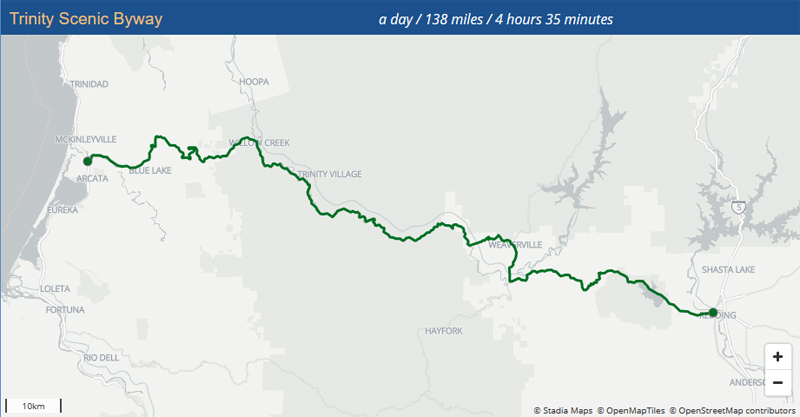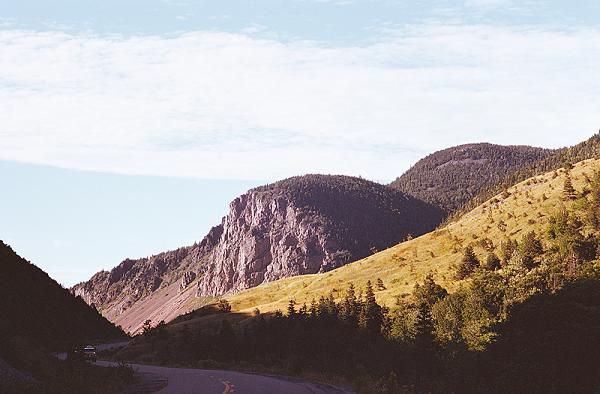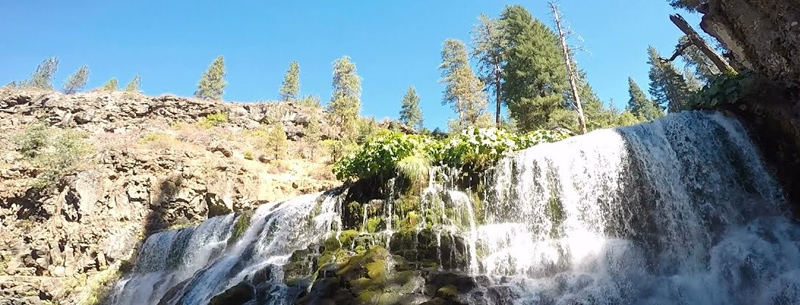Highway 299 was designated the “Trinity Scenic Byway” in 1991. The Theme of the route, “From the Valley Oaks to the Redwood Coast” was chosen by the Forest Service to feature the wide variety of plant and animal life that exists in the various climates zones along the highway. This scenic drive also features the cultural and historical aspects of the region, from the prehistoric Native American tribes to the timber workers and gold miners of the 20th Century.

The third-largest man-made lake in the state of California is Trinity Lake, which offers hundreds of hidden coves and numerous opportunities for fishing, camping, swimming, or just watching the wildlife. You can stay in a houseboat on the lake or find a place to camp or lodge on the northwestern shore of the lake.
However, the lake which gives the Trinity Scenic Byway its name is not the only body of water the byway passes through. There’s also Lewiston Lake and the Trinity River, not to mention many small, sparkling streams. In the spring, look near the rushing waters and granite cliffs and you can see the drooping purple-colored blossoms of the redbuds.

The byway goes through some of the most beautiful areas in Trinity and Siskiyou Counties. Interestingly enough, these are the same rugged trails used by gold miners and settlers in the 19th century. You can see the same dramatic vistas and scenic views that inspired those adventurers to stay, even when the gold played out.
Weaverville
Weaverville is a historic mining town that’s well worth a stop on your Trinity Scenic Byway trip. Its rich heritage can be seen in a number of historic sites and beautifully preserved buildings. To see what Weaverville was like during the heart of the gold rush, visit the J. J. Jackson Museum. Or, you can visit the oldest continuously-used Chinese Taoist temple, Joss House. Who knows? You might feel like stopping in for a prayer of thanks after you tackle the whitewater rafting at Burnt Ranch Gorge – beginners need not apply!
Shasta State Historical Park
The Shasta State Historical Park – the next stop on the trip – is another great place to experience what life was like in a gold rush boomtown.
Next, head from Weaverville along Rush Creek and the Trinity River, and you’ll find Lewiston, which was the support system for Weaverville during the gold rush. If you’re in Lewiston during the late summer and fall, be sure to head up to the Trinity River Hatchery to see the salmon and steelhead runs, along with all of the hatchery operations. Naturally, the fishing is amazing along this river. Lewiston Lake is also known for its wildlife – from bald eagles and osprey to migrating songbirds – and Mt. Shasta and Mt. Eddy, north of Lewiston, are truly beautiful to behold.
Lake Trinity
There are a number of different places to camp or lodge at Lake Trinity, particularly the northwestern shore. At the Trinity Center, you can shop, dine, or just visit for a while. While you’re in the area, a side trip to Coffee Creek is well worth the time. Be sure to continue north up Highway 3 to the Trinity Divide. Here, you can see the Trinity River continue to the west and the Sacramento River continue to the East. This is also where Trinity and Siskiyou counties meet, and you can access the Pacific Crest Trail here. You won’t believe your eyes when you see the wonderful views.
Whiskeytown Shasta-Trinity National Recreation Area
Finally, the Whiskeytown Shasta-Trinity National Recreation Area is a great place to take the family to spend a day or two amongst a forest rich with dense evergreens. The Oak Bottom Campground is a great place to spend a night roasting marshmallows and enjoying the beauty of nature. Or maybe a junior firefighter course or panning for gold is more what you have in mind. Whatever your interests, you’ll find something to keep the whole family occupied at this beautiful campground.
